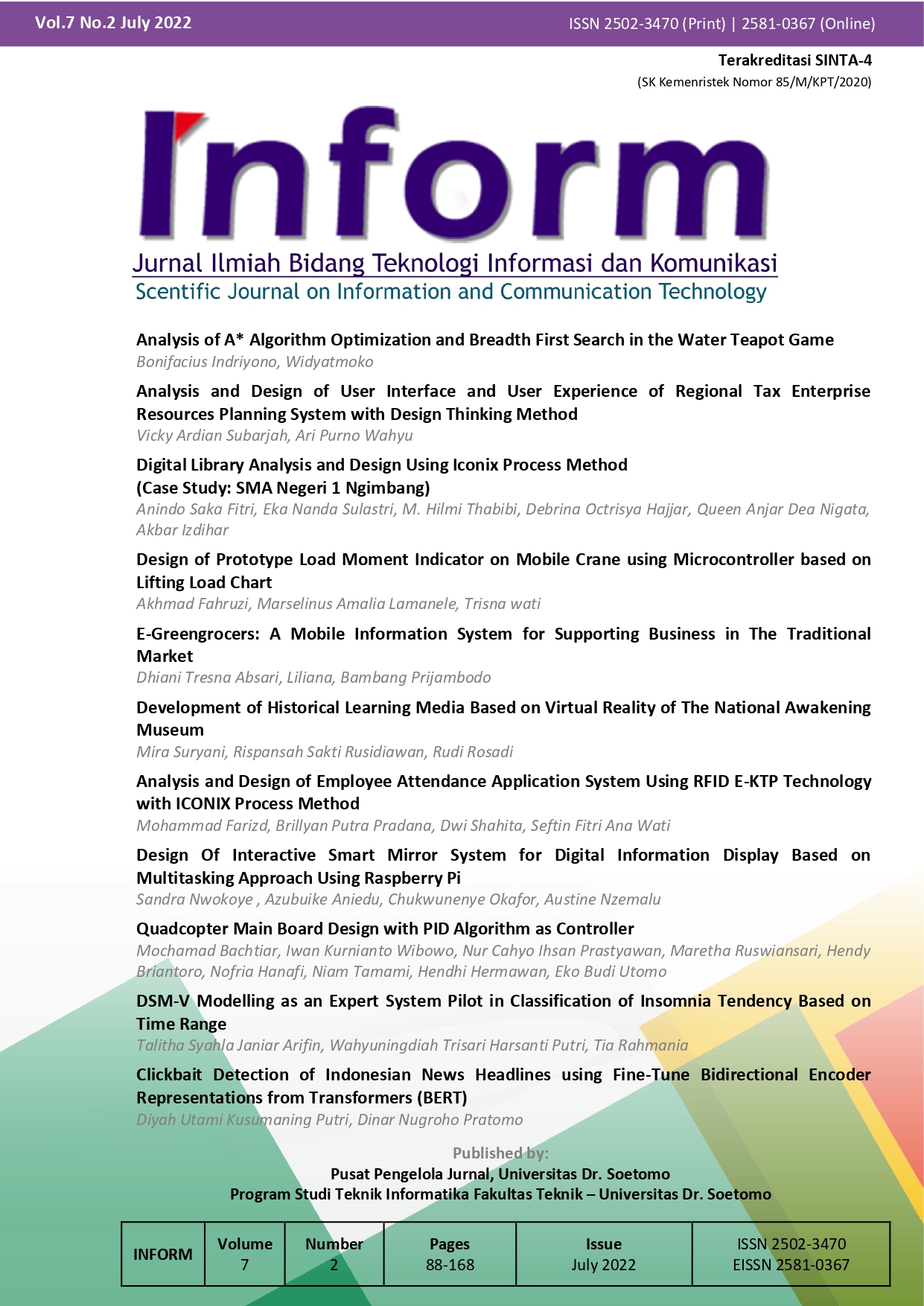Design of Prototype Load Moment Indicator on Mobile Crane using Microcontroller based on Lifting Load Chart
 Abstract views: 445
,
Abstract views: 445
,
 PDF downloads: 361
PDF downloads: 361
Abstract
A load moment indicator (LMI) is an electronic device on heavy equipment cranes that can provide information and a warning system to operators in the event of an overload during the lifting load process. This tool has a very important role because it provides accessible information to the operator about the safe working load (SWL) that the crane can lift. Mobile cranes have a high accident potential when compared to tower cranes, and this is because mobile cranes have high mobility. In this paper, a prototype LMI has been made on a mobile crane based on a microcontroller that can provide value. The method used is an algorithm to find the closest value from the lifting load chart of a crane car. The programming algorithm is still manual, namely by equating and comparing boom crane conditions such as boom length, boom angle, and radius contained in the lifting load chart with the results of measuring boom crane conditions by sensors. The nearest value search algorithm follows the rules of how to read the mobile crane lifting load chart. The test results show that the sensors used to measure boom length, boom angle, and actual load each have a maximum relative error of 0.92%, 8%, and 4%, respectively. Meanwhile, to find the SWL value, the comparison scanning method can provide the SWL value according to the lifting load chart of the mobile crane. It can provide accurate information on whether the lifting load process is safe or overloaded.
References
A. Peurifoy, R.L.; Schexnayder, C.J.; Shapira, Construction Planning, Equipment, and Methods, 7th ed. New York, NY, USA, 2009.
J. K. Irizarry, "Optimizing Location of Tower Cranes on Construction Sites through GIS and BIM Integration," J. Inf. Technol. Constr., vol. 17, pp. 351–366, 2012.
J. H. and S. K. Donghoon Lee, Jun Young Park, "Automatic design algorithms for securing the ground contact stability of mobile cranes," Vis. Eng., vol. 2, pp. 1–13, 2014.
Y. . Yu, "Forensic investigation on crane accidents," Int. J. Forensic Eng, vol. 3, p. 319, 2017.
D. V. M.F. Milazzo & G. Ancione, V. Spasojevic Brkic, "Investigation of crane operation safety by analysing main accident causes," in Risk, Reliability and Safety: Innovating Theory and Practice – Walls, Revie & Bedford (Eds), 2017, pp. 74–80.
Z. Lei, H. Taghaddos, U. Hermann, and M. Al-Hussein, "A methodology for mobile crane lift path checking in heavy industrial projects," Autom. Constr., vol. 31, pp. 41–53, 2013, doi: 10.1016/j.autcon.2012.11.042.
Y. C. Chang, W. H. Hung, and S. C. Kang, "A fast path planning method for single and dual crane erections," Autom. Constr., vol. 22, pp. 468–480, 2012, doi: 10.1016/j.autcon.2011.11.006.
Z. Lei, H. Taghaddos, J. Olearczyk, M. Al-Hussein, and U. Hermann, "Automated Method for Checking Crane Paths for Heavy Lifts in Industrial Projects," J. Constr. Eng. Manag., vol. 139, no. 10, p. 04013011, 2013, doi: 10.1061/(asce)co.1943-7862.0000740.
H. S. Gwak, H. C. Lee, B. Y. Choi, and Y. Mi, "Ga-based optimization method for mobile crane repositioning route planning," Appl. Sci., vol. 11, no. 13, 2021, doi: 10.3390/app11136010.
B. J. Yoon, K. S. Lee, and J. H. Lee, "Study on overturn proof monitoring system of mobile Crane," Appl. Sci., vol. 11, no. 15, 2021, doi: 10.3390/app11156819.
Y. 5. Fang, Y. and Cho, "Advance Crane Lifting Safety through Real-time Crane Motion Monitoring and Visualization," 2015.
M. Al-Hussein, S. Alkass, and O. Moselhi, "Optimization Algorithm for Selection and on Site Location of Mobile Cranes," J. Constr. Eng. Manag., vol. 131, no. 5, pp. 579–590, 2005, doi: 10.1061/(asce)0733-9364(2005)131:5(579).
P. G. Vishay, "Model 1022 Single-Point Aluminum Load Cell Model 1022," pp. 1–2, 2012.
E. Characteristics, W. E. Hybritron, and E. Characteristics, "3549 - 10-Turn Precision Potentiometer," pp. 1–4, 2003.
T. Wyatt, "Rotary encoder selection," Control Eng., vol. 58, no. 3, pp. 38–40, 2011.
cranehunter, "How to read a Crane Load Chart," 2021. https://www.cranehunter.com/how-to-read-crane-load-chart.
Copyright (c) 2022 Akhmad Fahruzi, Marselinus Amalia Lamanele, Trisna wati

This work is licensed under a Creative Commons Attribution-ShareAlike 4.0 International License.
Authors who publish with Inform: Jurnal Ilmiah Bidang Teknologi Informasi dan Komunikasi agree to the following terms:
-
Authors retain copyright and grant the journal right of first publication with the work simultaneously licensed under a Creative Commons Attribution License (CC BY-SA 4.0) that allows others to share the work with an acknowledgment of the work's authorship and initial publication in this journal.
-
Authors are able to enter into separate, additional contractual arrangements for the non-exclusive distribution of the journal's published version of the work (e.g., post it to an institutional repository or publish it in a book), with an acknowledgment of its initial publication in this journal.
-
Authors are permitted and encouraged to post their work online (e.g., in institutional repositories or on their website) prior to and during the submission process, as it can lead to productive exchanges, as well as earlier and greater citation of published work.













